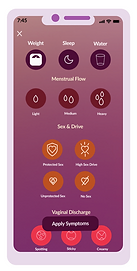This was my "product for social good" project for my Google UX Design Certification, I created a responsive website and mobile app that would streamline the women's healthcare process in one product.
BRIYA


Role
Industry
UX/UI Designer
Health & Wellness
Timeline
June-August 2022
Area of Focus
UX Design, User Research, Affinity Diagrams, User Journeys, User Testing, Wireframes, Prototypes, Mockups

Define
Problem: Women in America have packed days and full schedules. Navigating the healthcare system can be very frustrating-especially for humans with uteruses! Dealing with tracking your period, being on top of your birth control, and scheduling gynecologist appointments, is already enough, not to mention regular check-ups. Women need a product that helps them connect to their bodies, log their symptoms, and schedule doctor's appointments in one place.
Solution: As a female designer, I feel I can make a difference using my insight and what I wish was different about the healthcare system in the US, help women be more proactive, connected, and empowered to be accountable for their health, all in one process.



Ideate
BRIYA came from seeing the need to develop a product of a women’s health app that connects patients with their doctors. I envisioned creating a product that would help users take the initiative to track their health and connect it to their healthcare providers with their consent, giving doctors a holistic picture of their patient's health.
I also wanted to encourage women to feel empowered by connecting to their bodies by tracking their menstrual cycles and symptoms, giving women more sovereignty over their bodies while giving their physicians more insight into the health of their patients.
I brain-stormed how I could make BRIYA meet the expectations of the user and businesses, be usable, be accessible and be visually compelling.
Research

I started by conducting research with 10 women ages 18-56 with varying needs from their healthcare providers: some were just beginning college, becoming sexually active, and were responsible for their health for the first time.
Others were professionals in their reproductive age that were considering getting off birth control for the first time in 15 years, other's were women who had just experienced menopause.
I asked them several questions from identifying what they wish they could change about their healthcare experience, to their own personal connection to their bodies and health. Can you easily contact your nurse or doctor's office if you have questions? Do you know what phase of your cycle you are in?Are you on birth control? If you have not experienced menopause, when are you expecting your next period?





Design
Now for the fun part- DESIGN PHASE! I started the design process with a good ol' fashioned paper wireframe sketches, using inspiration for the layouts from the websites I audited. I kept in mind how to make the site especially accessible for our target users.
On the original site, all the content was on one page. Users had to continuously scroll to access the information they needed, whether it was general information about programming, events, or the app.
Organizing the content into categories was my starting point, the I created paper wireframes for potential layouts.I kept what features were most intuitive and usable, then moved on to create lo-fi wireframes in Adobe XD and Figma.


Evaluate
Based on various feedback from my participants in my usability testing and peers from my course, I continually iterated my design over the span of 5 weeks with 3 major improvements:
I. I added a notifications button so that users could check any updates from the app.
II. Probably the most important feedback I received from my user testing was adding a confirmation page before the appointment was booked, and giving users the option to go back and change those details if needed.
III. I Added an accessibility button for users who need screen-readers, different sized text, or need to turn on the seizure safe option for them to be able to have a usable and enjoyable experience with the product.








The Final Product
In the design world, we know the design process is not straightforward by any means! As the weeks went by at my in my course, I continuously went back and iterated my designs, and I loved how it came out: fun, femme, usable, and professional.
Reflecting back, I would change the color palette of my design to make it more inclusive for LGBTQ+ users. That's the best part of the design process, you can always find more growth opportunities and keep refining your designs!

